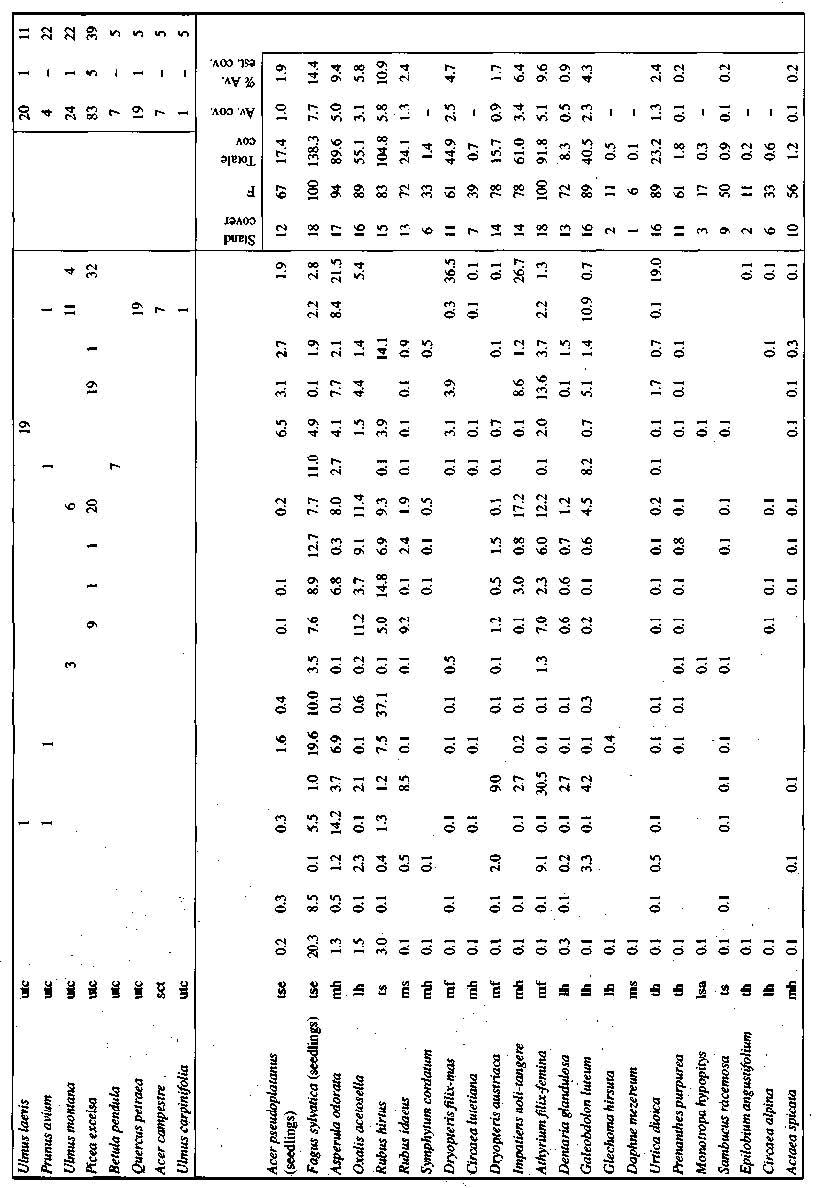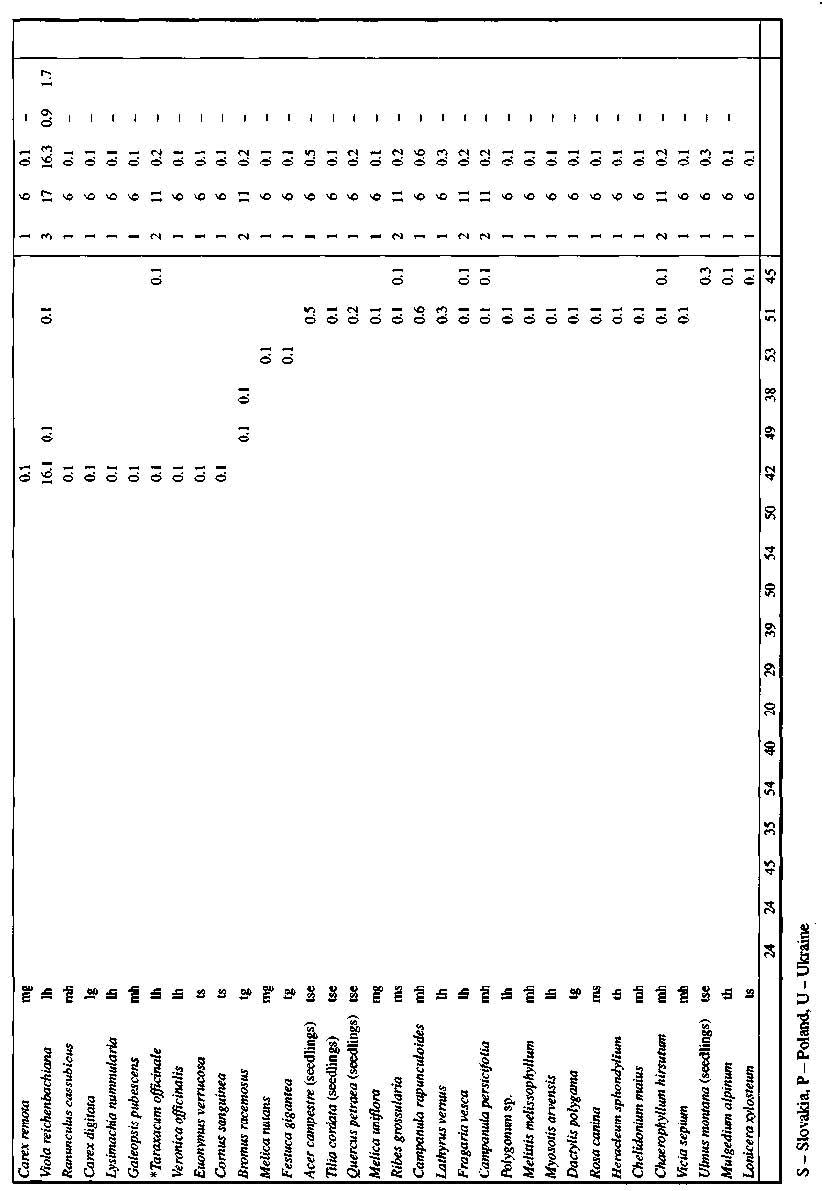
- •Composition, structure and ecological aspects of Mesic Old Growth Carpathian Deciduous Forests of Slovakia, Southern Poland and the Western Ukraine
- •Introduction
- •Field methods
- •Laboratory procedures
- •Analytic methods
- •Floristic composition
- •Life form analysis
- •Tree composition
- •Dominance patterns
- •Tree size classes
- •Canopy and tree heights
- •Biodiversity
- •Tree reproduction
Floristic composition
A total of 155 taxa in 54 families were recorded in the 18 mesic old growth forests. The largest families were Gramineae and Labiatae, each with eleven genera. Compositae included nine genera, Rosaceae and Dryopteridaceae seven, Liliaceae, six, Onagraceae, Cruciferae, Ranunculaceae and Cyperaceae, five, Boraginaceae, Caprifoliaceae and Umbelliferae four, Scrophulariaceae, Orchidaceae, Juncaceae, Caryophyllaceae, Corylaceae, Ulmaceae, and Campanulaceae, three. Another 15 families were represented by two genera and fully 19 had only a single genus.
At the generic level the two most significant were Carex and Dryopteris with five species each. Only Galeopsis included four species but Acer, Ulmus, Circaea, Dentaria, Luzula and Stellaria had three and Rubus, Symphytum, Impatiens Sambucus, Epilobium, Viola, Lysimachia, Veronica, Polygonatum, Polystichum, Lonicera, Festuca, Ranunculus, Melica and Campanula had two. Fully 92 of the genera involved in the composition of these stands were represented by just a single species.
At the specific level, 54 (35%) are represented in only a single stand and an additional 30 (19%) were in just two stands. Thus more than half of the taxa (54%) have very limited presence in these old growth forests.
It is a difficult task to recognize introduced species, and yet many have been transported from distant locations in America, tropical South America, central Asia, the steppes
Table 2. Mesic Old Growth Deciduous Forests: Eastern Europe. Compositional data - trees, tree seedlings, shrubs, herbs, environmental features.

P. F. Maycock еt al.: Mesic Old Growth Carpathian Deciduous Forests

Fragm. Flor. Geobot. Ann. 45, Pars 1-2,2000

P. F. Maycock et al.: Mesic Old Growth Carpathian Deciduous Forests

Fragm. Flor. Geobot. Ann. 45, Pars 1-2,2000

P. F. Maycock et al.: Mesic Old Growth Carpathian Deciduous Forests

of Russia and even as near as Asia Minor or the Mediterranean region, (Kornas 1953, 1954) to Eastern Europe. Despite this knowledge and a listing of synanthropic species reported, it is difficult to know precisely which species may have penetrated these old growth systems in the event of disturbance natural or otherwise. Added to this is the fact that natural species of disturbed situations could also invade. It is assured that *Impatiens parviflora, *Stellaria media, *Taraxacum officinale and perhaps Galeopsis tetrahit,
G. bifida and G. pubescens, the three former definite introductions, and the three latter perhaps native species of disturbed habitats, can be considered atypical and not ecological members of this forest system.
Life form analysis
Life form of each species is designated adjacent to the name in Table 2. Seedlings of the canopy trees which contributed to the understorey of these forests are also designated and add to the total number of life form entities. The abbreviations of the life forms included are listed at the bottom of the table. The summary of the analysis is included in Table 3 in the left hand column for the European forests.
Of the 17 tree species found in the 18 stands, 88% regularly occur as mature trees in the upper canopy and 12% in the lower canopy. No trees are members which regularly are found predominantly as just saplings. Saplings (7%) and tree seedlings (8%) significantly contribute to the lower forest layers. Among the shrubs the tall shrub form is best represented (6%). Low shrubs are not present. Medium herbs have the highest representation (22%) but low herbs are also well represented (18%). Medium graminoids (5%) and medium and low ferns (3%) are best represented in these groups.
